Top Story: Public Safety
Here comes the rain
February 26, 2014
The good news is that the rain has finally arrived.
Unfortunately, in some parts of Southern California, that threatens to be the bad news too.
Parched by drought and charred by wildfires, Los Angeles County has spent the week both cheering and dreading the Pacific storm systems that are predicted to soak California—and perhaps Sunday’s Academy Awards—with the wettest weather L.A. has seen since 2012.
“On one hand, the region is in sore need of drought relief, so we’re happy to have it,” says Kerjon Lee, county Department of Public Works spokesman. “But the hillsides around the Colby Fire, the Madison Fire, the Powerhouse Fire, even the Station Fire—those areas haven’t recovered.
“The hills no longer have vegetation or trees or shrubs to prevent erosion. And the upper crust of the soil has been scorched, so it’s less absorbent. Water runs across it as if it had a wax surface.”
In other words, don’t just grab an umbrella, L.A. County. Get ready for mudslides, too.
At the Department of Public Works, the situation is all-hands and the mission is twofold—first, to make sure in this drought that every possible drop of rainfall is captured, and, second, to protect local homeowners and businesses from a potential onslaught of coursing storm water and debris.
“We try not to be alarmist, but the threat right below the burn area of the Colby Fire in the foothills above Glendora is pretty serious,” Lee says.
To that end, he says, the department has been partnering not just with Glendora but with cities throughout the foothill burn areas of the San Gabriel Valley. So far, DPW engineers have advised some 700 county homeowners and businesses on ways to protect their property in the event of rain.
Public Works crews also have been working since last year with state and local agencies, the U.S. Geological Survey and others to assess risk, clean out debris basins and install crib dam structures at strategic locations in burn sites.
Drought notwithstanding, the storm preparations have been intensive. In the area of last May’s Powerhouse Fire alone, for instance, the county has installed nearly a mile’s worth of concrete barricades, or k-rail, along Walkatop, Munz Ranch, San Francisquito Canyon and Elizabeth Lake roads, plus metal standpipes at more than a dozen locations and more than 2,100 feet of embankment protection, all during the last eight months.
That’s not counting the routine storm preparations the department does every year in the county’s massive flood control system, which includes 14 major dams, 487 miles of open channels and 2,919 miles of storm drains. Or the prep work done by Los Angeles city sanitation crews, whose jobs have included clearing the catch basins near Hollywood’s Dolby Theatre, where the red carpet for Sunday’s Oscars is already out (and covered in rainproof plastic).
Nor does it include longer-term projects like La Canada’s Mullally debris basin, which was expanded in late 2010 after winter storms the prior year clogged its drainage system. (Debris from the 2009 Station Fire had been brought down by the rainstorms, and the backup had inundated nearby homeowners with a wall of mud.)
While DPW crews try to prevent storm water from inundating local roadways, county “storm boss” Michele Chimienti , who heads dam operations for the department’s water resources branch, will be trying to save as much of it as possible.
This week’s storms, heavy as they may end up being, won’t reverse the drought that has dogged California for the past three years; in fact, the overall lack of precipitation has been such a concern that this week, the Board of Supervisors extended the county’s lease on its two Super Scooper fire-fighting aircraft.
But one function of the county dams is to gather water that can be released periodically to replenish the underground aquifers that, in turn, generate about a third of the region’s drinking water.
Right now, Lee says, most of those dams are at less than 5% capacity, so there’s plenty of room for more.
While the county battens down the hatches of its infrastructure, homeowners can make their own storm preparations.
Appearing before the Board of Supervisors this week, Public Works Director Gail Farber reminded the public that the county’s Coordinated Agency Recovery Effort web site will be updated as the storm progresses with information on road conditions, flooding, forecasts, emergency contacts, disaster preparedness and assistance programs. (For details, click here.)
The Los Angeles County Sheriff’s Department suggests that, if you haven’t already, you should sign up for free public safety alerts from the department via Nixle. They also are offering tips on storm-proofing your vehicle—and your driving habits.
DPW also has this handy list of places to obtain free sandbags and this free guide to flash flood preparedness. For homeowners interested in rain barrels, the City of Los Angeles offers this guide to rainwater harvesting.
And one more bit of advice from the experts: Don’t forget to turn off your sprinklers. With any luck, the upside of this storm will carry over onto your water bill.
Posted 2/26/14
Some straight talk from new sheriff
January 29, 2014
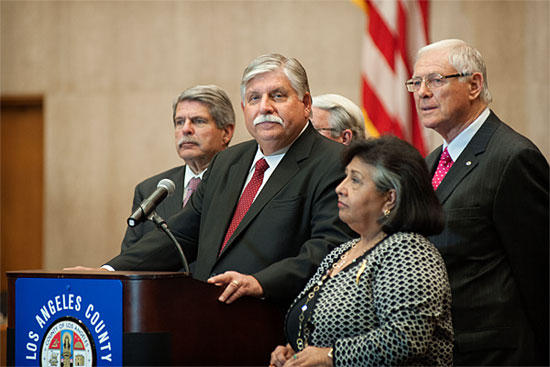
Interim Los Angeles County Sheriff John Scott (center) is flanked by supervisors as he meets the press.
After 36 years on the Los Angeles County Sheriff’s Department—with jobs ranging from street patrol in Lakewood to overseeing the country’s largest jail system—John Scott did not like what he was seeing.
“I thought the direction of the department was taking a turn that I did not want to be part of,” Scott recalled. “I saw diminished accountability. I saw fragmentation within the department. I saw some people who did not represent the best interests of the department.”
Scott said he felt “an obligation to talk to the sheriff.” But after voicing his concerns, he said he did not believe he had the support he needed “to fight the good fight.” So in March of 2005, he retired.
But on Tuesday afternoon, nearly nine years later, he was back, standing before a bank of TV cameras in the downtown Hall of Administration. He was flanked by members of the Board of Supervisors, who had just selected him as the department’s interim sheriff. His mandate: to keep the troubled agency moving swiftly toward reform until the election of a new sheriff either in the June primary or November runoff.
Scott will replace Sheriff Lee Baca, who officially retires on Thursday at noon. Baca’s departure comes after more than two years of steady controversy that eroded the agency’s reputation, including the recent indictments of 18 current and former members of the department for alleged brutality in the jails and obstruction of justice.
With no incumbent on the ballot, the race to succeed Baca has turned into one of the most heavily contested in the department’s recent history. At the same time, Baca’s unexpected retirement put enormous pressure on the Board of Supervisors to find an interim sheriff who would aggressivelyimplement reforms recommended in 2012 by the blue-ribbon Citizen’s Commission on Jail Violence. “We didn’t want a caretaker,” said Supervisor Zev Yaroslavsky. “And we didn’t want someone distracted by campaigning for the job.”
Scott seemed to be a good fit on both counts.
Besides his years of service in Los Angeles, Scott has spent the past 5 years as the undersheriff in Orange County. There, he has helped the agency recover from a sensational corruption scandal involving ex-Sheriff Michael Carona, who ended up in federal prison for witness tampering. Scott was recruited by Carona’s successor, Sandra Hutchens, a former division chief in the Los Angeles County Sheriff’s Department. (Scott, who is taking a leave of absence from his Orange County post, will return there after Baca’s replacement is sworn in.)
In an interview Wednesday with a writer for Supervisor Yaroslavsky’s website, Scott said his first—and top—priority will be to make sure everyone on the command staff is “in alignment” with the mission of bringing substantive reform and accountability to the department so they can effectively communicate it throughout the organization.
“I need to know that I have their complete buy-in,” he said. “If I don’t, then there’s going to be changes. I’m not bashful about that.”
Scott said he’s optimistic that changes in policy and direction can come quickly. But he said he’s realistic about the deeper cultural changes. “That’s a time-tested kind of process,” he said. “It’s like turning that big aircraft carrier.”
In Orange County, he said, some members of the department who resisted change ended up leaving the department because “it was heading down a different path—not one they chose. What you’re left with are people who have bought in.” He said he suspects the same thing could happen in Los Angeles.
For help in his new job, Scott has turned to a former colleague, retired Field Operations Chief Neal Tyler, who’ll return as an executive officer.
“I need immediate assistance from someone I know and trust,” Scott said of Tyler, who oversaw operations in Malibu/Lost Hills, Crescenta Valley, Altadena and Lancaster, among other places. Scott said that Tyler, like him, “had a great deal of difficulty with things that were going on.” Tyler left the department about a year ago, Scott said.
Scott said one of the challenges they’ll face is keeping the political race for sheriff from creating divisions and distractions in the rank and file. The current field includes two high-ranking insiders, as well as two former members of the department who’ve maintained alliances on the force. He said he will make it clear to the two inside candidates that “the operation of the Sheriff’s Department is Priority One and that their campaigns are on their own time…The mission is what we need to focus on, not the candidates. We need to keep this ship righted.”
On a personal level, Scott said his wife, Alice, strongly supports his return to the department so he can finally press ahead with the reforms he wanted to initiate before he felt compelled to leave. She’s a former sheriff’s captain, who retired in 2010, and, like him, did not like what she saw.
“She is one of those who watched internally and then from a distance and felt very disappointed and frustrated,” Scott said, adding: “I want to bring back the department’s premiere status.”
Posted 1/30/14
Audit raps sheriff fund management
January 16, 2014

L.A. County Auditor-Controller Wendy Watanabe at the Hall of Administration. Photo/Los Angeles Times
A new Los Angeles County audit has revealed that the Sheriff’s Department did not meet even the most basic—and required—accounting practices in its management of numerous special funds, which have accumulated $160 million with no written plans on how the money should be spent.
Some of the money has flowed into these Sheriff’s Department funds from various fees imposed on the public, including a slice of court fines and assessments on vehicle registrations, according to Auditor-Controller Wendy Watanabe.
In a review of three recent fiscal years, the Auditor-Controller’s office found that the department used only 57% of the $370 million that had built up in eight special funds, each of which is legally restricted to purposes ranging from drug investigations to vehicle theft programs to automated finger-printing systems. The California controller’s office requires that specific spending plans must exist for these growing pots of money.
“Excessive revenue indicates that the counties should reduce fees or establish reserve accounts,” auditors said.
The Sheriff’s Department did not dispute the findings, saying it would evaluate the special funds and determine “appropriate expenditure requirements and spending plans.”
But during a public briefing on the audit for Board of Supervisor staff members on Wednesday, Sheriff’s budget official Glen Dragovich downplayed the significance of the rising fund balances. “There’s a plan,” he said, “but it’s just not written down.” He said the department has taken a conservative approach to spending “because we want to make sure we have money for future years.”
The audit is certain to raise new concerns about the department’s top-level management. It comes at a time when the agency already is confronting problems across its operations, including, most significantly, the recent indictments of 18 members of the force for alleged brutality, corruption and obstruction of justice. On January 7, Sheriff Lee Baca announced he would not seek re-election to a fifth term.
Beyond criticisms centering on the $160 million in unspent funds, auditors took the department to task for a variety of other violations of county fiscal policies involving management and oversight of special revenue and trust funds. Although there was no evidence of malfeasance, the department’s failure to comply with rigorous accounting measures increases the odds that public monies could be placed at risk, the audit suggested.
Among other things, the Sheriff’s Department breached government rules by transferring $1.6 million in unclaimed funds to its own operating budget rather than providing the money to the Treasurer and Tax Collector. That office is responsible for publishing a newspaper notification of the unclaimed funds. If no one comes forward—county inmates, for example, who’d surrendered their property at the time of booking—then the money should be placed in the county’s general fund.
“Transferring unclaimed funds to a department’s revenue,” the audit stated, “may result in the use of funds that were not authorized by the Board of Supervisors as part of a publicly accessible appropriations process.”
The Sheriff’s Department management said it was unaware of the requirements for unclaimed funds.
To read the full audit, click here.
Heroes in hardhats
January 8, 2014
They have rescued small children from oncoming traffic. They have brought a victim of attempted murder back from the brink of death. They have braved rising floodwaters and raging house fires. Last month, they dragged an unconscious driver from a burning SUV seconds before the truck’s gas tank exploded.
Not all first responders are sheriff’s deputies or firefighters. Some also find themselves in the occasional life-and-death situation while minding the county’s infrastructure at the Department of Public Works.
Emergency response has been among DPW’s core services since 1985 when the department was created, though the public tends to be more familiar with the department’s work in engineering, flood control and road maintenance. DPW maintains a 24-hour emergency operations center, and employees there are trained for disaster.
In fact, over the years, so many DPW hardhats have stepped into the breach so often that after a beloved employee named Kelly Bolor died in Iraq in 2003 while serving as a member of the U.S. Army Reserves in Mosul, the department created an in-house award for valor that has been presented in the wake of a number of incidents.
Since that date, nearly two dozen DPW employees have received the Kelly Bolor Award for heroism of one sort or another, from Ignacio Orozco Jr., who used a county dump truck to head off a potentially fatal car crash on Imperial Highway last year to members of Road Maintenance Division Crew 551, who extinguished a raging house fire in 2011 near their Antelope Valley work site, to Gary Clinton, who used his motorgrader to rescue panicked motorists from a flooded crossing in the high desert in 2005.
“I’ve been with the county for 29 years, and I think we’ve all at one time or another been first responders in some kind of situation,” says Steven Smith, a road maintenance superintendent in Agoura whose crew members, Lowell Johanknecht and Enrique Ramos, are expected to be nominated this year for pulling a woman from a burning SUV on Mulholland Highway on September 18.
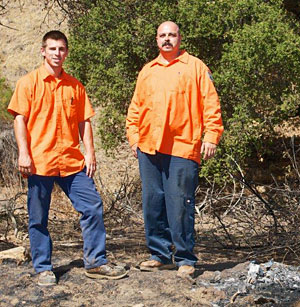
Lowell Johanknecht, left, and Enrique Ramos are the latest Public Works heroes. Photo/ Christian Garcia DPW
“If an accident happens and you’re around, you rise to the occasion. This job can be dangerous, too.”
That certainly was the case for the award’s first recipient, Marco Andonaegui, who was replacing traffic signs in 2004 on Topanga Canyon Boulevard near the 101
Freeway when he glanced up and saw a child tumble out of an SUV.
“He was 8 years old and his buckle must have come undone,” says Andonaegui, a 30-year DPW employee who says he still gets chills when he thinks of how close the child came to being hit by oncoming traffic.
“I was alone, going the opposite direction and they were just a couple a cars in front of me.”
Andonaegui scrambled out of his county vehicle, jumped the median and grabbed the child as the SUV drove on, the child’s mother oblivious to what had happened.
“Cars were swerving around us, braking around us, the little boy was crying and crying,” recalls Andonaegui. “I don’t know how the heck I didn’t get hit, let alone the little kid.”
Fifteen minutes later, he says, the mother circled back, frantic.
“She was desperate and grateful, and she must have given me 20 or 30 thank yous, but she was crying so hard, she forgot to ask for my name or give me hers,” he remembers.
It was only afterward, he says, that he learned she had written down the phone number on the back of his county truck and called the department. A father of grown children, he says he never heard from the woman again and still doesn’t know her name or her son’s name, but he still keeps his award plaque in his Lynwood living room.
Dam Operator Gary Elrod says he and his fellow crewmen on the remote San Gabriel Dam compound likewise never heard again from the young man they rescued.
It was early on a Tuesday morning, May 29, 2007, and the seven dam workers, several of whom live on the isolated site high in the San Gabriel Mountains, were starting their day early when Assistant Dam Operator Benny Velasco spotted a body in a drain near the roadside.
“It looked like he’d been attacked at another location, stuffed in the trunk of his car, driven to the entrance area of the San Gabriel Dam in Azusa Canyon and left there for dead,” recalls Elrod. “I personally counted nine stab wounds.”
A 25-year DPW employee who had worked in his youth with an emergency response team in Saudi Arabia, Elrod says he grabbed his blanket and safety gear and started to administer first aid.
As the crew waited for paramedics to arrive, Elrod tried to keep the barely coherent victim from falling into unconsciousness.
“This isn’t your time,” he remembers repeating to the young man as the sun rose over the mountains. In the hospital, Elrod says, the victim, who was from Whittier, refused to name his attacker, and the case was still unsolved three months later when he stopped asking about it.
“He denied everything he’d said to me when the sheriff questioned him later,” says Elrod. “All I know is, he’s out there somewhere with a horror story to tell his children and he’s lucky we came along when we did.”
The workers say they don’t mind that the recipients of their help often have no idea who they are or what department they work for.
“It makes you feel good just to be able to help,” says Johanknecht, the 23-year-old road laborer who pulled the woman from the burning truck last month on Mulholland Highway near Las Virgenes Road.
Johanknecht, who lives in Redondo Beach, says he had finished his shift at the Road Maintenance Division’s Yard 339 near Agoura Hills and was heading off to meet his girlfriend at their community college when he noticed the plume of smoke and the overturned Chevrolet Suburban. Pulling over on his motorcycle, he called 911 and ran toward the crash site.
“The 911 operator asked if anyone was in the car, and I said yeah, there’s a lady in the driver’s seat,” he remembers. “Right then, an older gentleman on a bicycle came up the hill and said, ‘What do you want to do?’ And I said, ‘Get her out!’”
Just then, he says, Ramos pulled over, having seen the skid marks, the smoke and his coworker’s abandoned Suzuki DR650. Working together, the three wrestled the woman, who appeared to be in her 40s, out of the black SUV and back toward the road’s shoulder.
“She was panicked and freaking out and pushing us away and in shock,” Johanknecht says, “and smoke was engulfing the car and all the air bags had deployed and blocked all the windows.”
As they carried the woman to safety, the SUV’s gas tank exploded, igniting a brushfire that engulfed nearly two acres before two Super Scoopers and four water-dropping helicopters were called in to contain it. Los Angeles County Fire Inspector Scott Miller could not release the woman’s name, but said she was transported to a local hospital. Ramos and Johanknecht say they never found out who she was and haven’t heard from her.
Johanknecht says his parents and girlfriend were “worried and proud at the same time” when they heard what happened, and wishes the crash victim—whoever she is—a speedy recovery.
“You never expect this, but you never know—we work out here in no man’s land, and a lot of things happen,” he says. “I just hope that someone would do me the same favor if something like that ever happens to me.”
Posted 10/15/13
Embracing a second chance
November 25, 2013
Gratitude is rare in criminal courtrooms, but for the women gathered on a recent Friday before Los Angeles Superior Court Judge Michael Tynan, thanksgiving was everywhere.
One was clean after an addiction that had crippled her since age 7. Another was in sober living after 30 years of shuttling between Skid Row and prison. Yet another was a middle-aged ex-con when she hit her deepest bottom, and she wept as she described the redemption she shared with the five women beside her.
“I was so tired,” 55-year-old Donna Majors said last week, as prosecutors and parole officers brushed away their own tears at the small graduation ceremony in Tynan’s downtown courtroom. “And I was given the chance to finally face my demons, to know who I am and finally be at peace.”
If the emotional scene seems a far cry from standard L.A. criminal justice, it may be because the program that spawned it is a departure as well. Since 2007, the Second Chance Women’s Re-Entry Court has been among the most successful diversion programs in Los Angeles County, offering an intensive yet cost-effective alternative to prison for hundreds of high-risk female felons.
The program targets parolees and probationers charged with new offenses, channeling them into a 6-month residential substance abuse treatment program in lieu of another term behind bars. That rehab, at the nonprofit Prototypes residential center in Pomona, is followed by up to 18 months of tightly supervised outpatient treatment, plus services ranging from parenting classes to educational and vocational training.
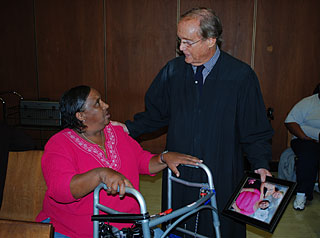
Judge Tynan greets program alum Georgina Moore, who presented him with a picture of her and her daughter.
Each woman checks in regularly before Tynan, who consults with therapists and court officers to determine when a participant can move to the next level of treatment. Those who relapse or reoffend return—often remorsefully—to county jail or prison, but most move on to sober housing, family reconciliation and even jobs and college.
At last count, 295 women had been formally admitted and 61 had gone back to jail or prison, according to a recent review conducted by the Public Defender’s Office. About 90% of the recidivists, the review found, were women who had not yet completed their treatment.
Of the 125 who have graduated so far, the review found, only eight—about 6%—have since gone back to jail or prison. By comparison, according to state figures, the recidivism rate in 2011 was 55.1% for female inmates.
“You’ve come a long way,” the judge told a glowing ex-con at the most recent graduation ceremony, glancing at a file that included her latest report card from Mt. San Antonio Community College. “You got an A at Mt. SAC! Congratulations! Gimme a hug! I remember when you came through that door looking like something the cat wouldn’t have dragged in on a bet.”
Well into his 70s, Tynan notes that he could be retired. But the judge—who also presides over the county “drug courts” and alternative sentencing programs for the mentally ill, military veterans and others—says that his is a labor of love.
This has been particularly true lately, he adds, as funding concerns have been looming over the program because of a new state law aimed at putting the brakes on California’s burgeoning state prison population. Under the AB 109 law, known as “realignment,” the county, rather than the state, has been given responsibility for supervising and incarcerating offenders whose most recent convictions are for non-serious, non-violent, non-sexual offenses.
But because the Women’s Re-Entry Court is largely underwritten by a state grant for parolees, women who once were prime candidates for the program—street people, hustlers and others whose long criminal histories stem from drug habits—are now ineligible because the state no longer supervises them.
And the county, which now oversees these offenders, doesn’t directly fund its Re-Entry Court participants. Under AB 109, these offenders are being channeled into other, less intensive programs underwritten by realignment money. If they re-offend now, they can only be placed in Re-Entry Court if an alternative funding source pays for their treatment—a grant for AIDS patients, for example, or for pregnant women.
Meanwhile, officials say that parolees who remain under state supervision now often require special consideration to get into the program, because they are more institutionalized, with more serious convictions.
Shari Crome, an assistant unit supervisor with the California Department of Corrections and Rehabilitation, says she’s frustrated “because I’ve been here almost since the beginning of the program, and I’ve seen the successes. There’s nothing else like it in the state, and it works.”

Deputy Public Defender Nancy Chand, a key member of the re-entry court team, congratulates the grads.
Deputy Public Defender Nancy Chand, who has represented most of the Re-Entry Court women, calls the AB 109 funding snag a rare sour note in a program that has transformed some of the most desperate lives in L.A.
“These women are really scarred,” Chand says. “Most come in with horrific trauma, and were victimized as children, enduring severe physical, sexual and emotional abuse and abandonment. Some can’t read and write. Some can’t work. Eighty-one percent have one or more mental health diagnosis and 50 percent have two or more. As one of my clients put it, they’re literally scraped off the streets.”
Currently, Tynan says, about 60 women at any given time are enrolled in the program, a little more than half of them paid for through the $500,000 annual state correction’s grant and the rest covered by a shifting and uncertain patchwork of federal, state and county grants to Prototypes.
The cost is about $18,000 a year for each woman, versus an incarceration cost of close to $50,000 a year in prison or more than $36,000 a year in county jail, not counting medical and mental health care. Officials at the Public Defenders Office estimate the program has saved tens of millions of dollars; many of its participants had been facing jail or prison sentences of 10 years or more.
Barbara Dunlap, for instance, was a 58-year-old homeless addict with 15 prison terms under her belt by the time she entered the program.
“I discovered alcohol before I started school, and I started school at the age of six,” Dunlap says. Her babysitter sold her to men when she was a child and by 21, she says, she was a prostitute with a criminal record. By the time her public defender sent her to Tynan’s courtroom, she was a 58, suffering from AIDS and hepatitis and was wheelchair-bound as the result of surgery stemming from a poisoned heroin injection.
Now 61, she is sober, living in permanent supportive housing, enrolled in college classes and a mentor at Prototypes. And at the ceremony in Tynan’s courtroom, she addressed the most recent graduates from her electric wheelchair, rolling back and forth across the courtroom, testifying like a preacher as a dozen state corrections officials watched from the jury box.
“When they found me, I was on the streets, and I don’t even know how they told me from the sidewalk—I was cold, my life was filled with stench and I was gray, without any life in me,” she proclaimed, her voice trembling.
“But they treated the whole woman—my health issues, my substance abuse issues, my anger issues. I didn’t know that anyone understood people like me.”
Taking the podium in Dunlap’s wake, the graduates told their own harrowing stories, weeping with gratitude as they thanked their therapists, probation and parole officers, prosecutors and defenders, families and, of course, the judge.
Brigitte Benjamin, 52, told the group that she had spent 30 years on Skid Row, and had expected to die there. Now, she is in a sober living facility and working toward her GED after 30 years on Skid Row.
Helen Navarro credited Tynan and Prototypes with forcing her to confront the roots of her addiction for the first time in the 20 years she had spent cycling in and out of prison on robbery and burglary charges. “I didn’t want to go deep-deep-deep,” said Navarro, a 51-year-old recovering crack addict—now sober and working as a receptionist at a country club in the San Gabriel Valley. “The counselors made me look at myself.”
Sandy Raymond, a 48-year-old mother of two who had lost more than half her life to crack addiction, did a little dance as Tynan handed her a certificate of completion. “I didn’t know nothing but going in and out of jail and stealing stuff,” she said. “But now I’m a secretary. I love my life.”
Over cupcakes and high fives from their families, the women also quietly gave thanks for the inner strength they were able to muster.
Brandishing her graduation certificate after decades of crime and addiction, Mary Willis said that for the first time in 25 years, she now has a relationship with her children. “I will always keep in the back of my mind what Judge Tynan told me,” she said proudly. “Give yourself a chance.”
Posted 11/25/13
On kids’ side against sex traffickers
September 18, 2013
Michelle Guymon understands why people pass by the children on the boulevards, looking but not really seeing youthful lives shrouded in peril and despair.
For years, she did it herself.
“I’ve seen young girls on the side of the road,” said Guymon, who joined the county’s Probation Department in 1989. “There comes a time in your life when you don’t even pay attention to that anymore because you’re on the phone, you’re on your way to work, you’re focused on the street lights…You just drive by stuff.”
She’s not just driving by anymore. Three weeks ago, Guymon was named the first director of the county’s Domestic Minor Sex Trafficking Project. She’s determined to help the system—and the public—see the grim reality of underage girls, some as young as 10 years old, being victimized by the sex trade.
Guymon, 52, said her own awakening was a long time coming. For years, like others in the criminal justice system, she had taken a dim view of those girls by the side of the road.
“I had looked at these young women as teenage prostitutes, and this was just the crime they committed, like this girl over here committed a crime for robbery,” she says. “And I remember having judgments about them, that this was their fault, this was their choice.”
An unexpected assignment to a subcommittee on underage sex trafficking in 2010 shook her world view. At first, she was puzzled by the terminology being used, assuming that “trafficking” was something that just happened to kids from faraway countries.
When she attended the first meeting, she discovered that everything she thought she knew was wrong.
“It wasn’t until that moment when I realized, oh my gosh, you mean these kids are not teenage prostitutes? They’re not out doing this and making lots of money as a career choice?” she said. “They’re being what we’d consider sexually exploited. It was a defining moment for me.”
Instead of being victims of shadowy international sex trafficking rings, young girls here in Los Angeles, she found, are being sold into what some have called sexual slavery by local street gangs and other opportunistic homegrown criminals.
Now those girls had a champion, on the inside.
“She is probably one of the most committed, action-oriented and solution-focused persons that I have worked with in a very long time,” said Fesia Davenport, chief deputy director of the county’s Department of Children and Family Services, which is developing its own plan to attack the problem as part of the countywide effort. “She doesn’t have any egotistical skin in the game. She’s willing to take a good idea from anyone.”
Working with a colleague, Hania Cardenas, Guymon began dedicating herself to the issue—even though both she and Cardenas were also working demanding fulltime jobs within Probation.
In the three years since then, the county, with Probation at the forefront, has emerged as a leader in raising consciousness about underage girls being trafficked. Guymon estimates that her department alone currently has 435 sex trafficking victims under the age of 18 currently under its supervision, with some 3,000 more between the ages of 18 and 24.
Even as officials continue to gather data to get a better handle on the scope of the problem, initiatives—like a special “Girls’ Court” in Compton—have been launched to help surround young victims of sexual exploitation with supportive services and the kinds of human connections needed to break the bonds they’ve developed with their pimps.
Commissioner Catherine J. Pratt of the Girls’ Court said it is essential to have someone in Guymon’s position to keep the momentum going. “There’s a lot of system change that we need to do,” she said. “And she’s a wonderful person for it.”
Guymon’s small team—herself plus “a mighty three” probation officers—are focused on building that kind of trust. “These kids have my probation staff on speed dial, 24 hours a day, seven days a week,” she said.
Monthly training sessions at a hotel in Downey have now reached nearly 3,000 county employees and community activists, with a waiting list stretching through November.
The Board of Supervisors recently unanimously voted to urge the state to increase penalties for men who pay for sex with underage girls—including higher fines and a requirement that they register as sex offenders. Guymon testified in favor of the action, along with officials including District Attorney Jackie Lacey and Long Beach Police Chief Jim McDonnell, who said that local gangs’ involvement in sex trafficking is similar to their incursion into the narcotics trade in the late ‘70s and early ‘80s.
Ultimately, Guymon believes the state should decriminalize prostitution for girls under 18 years of age. But she acknowledges there’s a long way to go before the system is ready to deal with all the “unintended consequences” that might result.
In the meantime, she and a cross-departmental team are pushing forward to develop new protocols and practices to attack the problem.
“Once you know better, you have to do better,” she said. “You’ve gotta do something. You can’t ignore it. Our kids are counting on us.”
Probation Chief Jerry Powers said he named Guymon to her new post because the scope of her work on the problem had “mushroomed.”
“Even having been in the profession as long as I’ve been it, I would have never guessed it was as significant as it’s turned out to be,” Powers said. “Michelle’s work has helped us understand the complexity of the issue and the magnitude of it.”
“I think she’s awesome,” added Cardenas, her probation colleague and partner in the effort. “We always laugh about how we complement each other so well. She’s so outspoken. She likes to present. I’m a better writer. She kind of ended up being the face of it, which is her strength.”
The oldest of seven children, Guymon grew up in St. George, Utah, aspiring to play college basketball and ultimately to become a women’s basketball coach at the university level.
She went on to compete in college but found another, more satisfying, court to play on when she accepted an invitation to become the recreation director at a boys’ group home. Eventually, that work led her to a job with the Los Angeles County Probation Department. Looking back now, Guymon, who has a bachelor’s degree and master’s of social work from Cal State San Bernardino, knows she made the right move.
“Life threw me a curveball and I was just hooked,” she said. “I really am a kid junkie on some level. I feel like it’s where I’m supposed to be.”
Posted 9/18/13
Historic fire’s legacy lives on
August 28, 2013

The Old Topanga Fire drove home the need for Super Scoopers. Topanga Messenger photo/Martin Nate Rawner
The first spark was sighted at 10:46 a.m. on the first Tuesday of November, 1993. It was hot. The Santa Anas were gusting. Fires had just consumed swaths of Altadena and Laguna Beach, and now came a 911 call to report a fire on Old Topanga Canyon Road, near the water tower. Minutes later, the smoke could be seen from a half-mile away.
Over the course of 10 days, the Old Topanga Fire would consume 16,516 acres, killing three people and injuring 21 others. Some residents will never forget the way it exploded through Malibu, hopping from canyon to canyon, cresting Saddle Peak in a 200-foot-long wall of flame.
But the fire also made another kind of history in Los Angeles County. In the wake of its devastation, the county became the first jurisdiction in California to begin regularly leasing the Canadian tanker planes known as “Super Scoopers”—a move for which firefighters were particularly grateful this week as a far-earlier-than-usual fire season hit Yosemite National Park, scorching a wilderness area the size of Chicago.
“The fires this year have been extreme,” says Los Angeles County Fire Chief Daryl Osby, citing the hundreds of fires that occurred this year throughout California. The Springs Fire struck in May, and then came June’s Powerhouse Fire, which destroyed more than 32,000 acres and some two dozen houses near Lake Hughes in a month that, in past years, has always been cool and foggy.
Lower-than-usual rainfall and a lack of June gloom, he says, have made the canyons as dry now as they usually are in autumn, when the Santa Ana winds typically turn L.A.’s canyons into fire hazards. Worse, the county hasn’t had a major fire since 2009, meaning that the county has mountains of parched vegetation to burn.
All of this, meanwhile, comes in the midst of a three-year drought that has disrupted conventional fire patterns. How much it all has to do with climate change is beyond his expertise, the chief says, but the upshot has been a new kind of fire season—bigger, earlier, less predictable and more lethal than ever.
“The Powerhouse Fire burned like it was September, and it wasn’t even being pushed by Santa Anas,” he says. “I can’t say yet whether this season is going to be the worst ever, but the potential is there.”
That, he says, is why the county moved up this year’s timeline by a full month for arrival of the Bombardier CL-415 Super Scoopers that it has leased for the past 19 years from the government of Quebec. Able to fly at speeds of up to 170 mph, the iconic yellow planes dip into oceans and lakes, pulling in 1,620 gallons of water in 12 seconds to dump from the air onto brushfires—a powerful tool for which canyon dwellers lobbied mightily after the 1993 fire.
“We’ve known since probably around February that we had the potential for a volatile fire season,” says Osby. “When we saw in June that the fuel moisture levels in our vegetation were already down to what we would normally see in September, we started collaborating with Quebec to see how early we could get the Super Scoopers.”
The planes arrived with their Canadian crews on August 15, as opposed to their usual start date in mid-September, and already they have been deployed on brushfires in Topanga and Calabasas.
“Your fire conditions in L.A. are worse than in the past years,” says Chief Pilot Carl Villeneuve, who expects to remain with the two leased planes until mid-December, if not longer. “Those two fires weren’t hard to put out because there are no big winds yet, but when the big winds come, that could change.”
Osby says the early Super Scooper deployment is just one part of a strategy to pre-empt a potentially lethal autumn. (The two planes were joined by an Erickson Air-Crane Helitanker, also contracted this year for extra backup.)
“We have also been aggressive with our fire prevention inspections, and in working with citizens to ensure proper brush clearance,” the fire chief says. “We provided additional training to our firefighters, getting them out to wild lands for practice. We did additional simulations with surrounding agencies, and intensified training with our incident management teams.”
The department has been urging the public to be vigilant, to become familiar with the department’s “Ready! Set! Go!” program and to evacuate when fire officials tell them to get out of a threatened area, rather than stick around to try to guard their houses.
“Our response capability is better now than it was 20 years ago,” Osby says. “We have additional aircraft, more sophisticated training and better weather predictions.”
Posted 8/28/13
Summer crimes hit LA’s promenades
August 7, 2013
The news of last weekend’s tragedy on the Venice boardwalk had scarcely broken when Finbar O’Hanlon began fielding the inevitable calls.
“I’m from Australia,” says O’Hanlon, a tech entrepreneur and musician who relocated eight months ago to Venice, “and my friends from overseas were all, ‘Come home! It’s not safe! What are you doing, living there?’ “
Across town, on Hollywood Boulevard, Silvia Figueroa is hearing a similar message. In June, a troubled panhandler stabbed a young woman to death on the Walk of Fame, a few feet from where Figueroa hawks bus tours of homes of the stars. Since then, she says, her mom in Echo Park hasn’t stopped calling—and it didn’t help when a so-called “bash mob” tore down the boulevard in July, randomly robbing people.
“She keeps telling me it’s not safe,” says Figueroa, who, at 23, is the same age as the stabbing victim. “She doesn’t want me to work in Hollywood anymore.”
It’s been an unsettling summer in Los Angeles’ tourist hotspots, with three high-profile violent incidents—the stabbing, the hit-and-run and the “bash mob” robbery spree—in two of L.A.’s most famous promenades.
Not so unsettling that the tourists have stopped coming—visitors from around the world jammed the Walk of Fame this week as usual, interspersed with the inevitable hustlers in Star Wars and Mickey Mouse costumes. And Venice’s beach carnival atmosphere was back within 24 hours after a transient plowed a 2008 Dodge Avenger onto the boardwalk Saturday, veering around traffic barriers to kill a 32-year-old Italian honeymooner and injure 16 others.
But the incidents have been worrisome enough to incite calls this week for improved security measures.
On Tuesday, the Los Angeles City Council voted to augment existing traffic barriers by temporarily blocking more of the nearly 30 streets and alleys on which cars can reach the boardwalk, and to study the possibility of more permanent barriers. Meanwhile, in Hollywood this week, local business representatives plan to present a set of recommendations to Mayor Eric Garcetti aimed at making the Walk of Fame and surrounding area safer.
The list, drawn up by Hollywood’s business improvement districts and Chamber of Commerce, asks, among other things, that the city’s aggressive panhandling ordinance be reviewed and tightened, that sidewalk CD vendors and tour operators be banned from Hollywood Boulevard and that street performers around Hollywood and Highland be required to register with the city, kept to a designated limit and banned from wearing masks.
Los Angeles Police Commander Andrew J. Smith says the demands are understandable, given the crimes’ shocking nature. But, he says, the incidents are anomalies in areas that already have extensive security. The LAPD, he says, has had 20 to 40 extra officers deployed in Hollywood since the June stabbing, “on bikes, cars, foot and horseback”, and deployment is “already robust” in Venice.
“Crime is down across the board in Los Angeles,” Smith notes. “And both Hollywood and Venice are extraordinarily safe, especially compared to the crime rates of ten or 15 years ago. But when something like this happens that gets attention, it gives a false impression.”
That attention worries Stuart Sarbone, 73, a retired businessman who lives so close to the boardwalk that he heard the Venice crash on Saturday from inside his home. Sarbone notes that both the Hollywood stabbing and the hit-and-run down the block from his home appear to have been committed by unstable men.
Nathan Louis Campbell, the 38-year-old Colorado transient arrested after Saturday’s incident, reportedly had a history of substance abuse, and 26-year-old Dustin James Kinnear, charged with killing Christine Calderon on the Walk of Fame, was said to have been in and out of mental health treatment since childhood.
Kinnear has pleaded not guilty to charges of murder. Campbell pleaded not guilty this week to one count of murder, 16 counts of assault with a deadly weapon and 17 counts of hit and run. His lawyer said that he is “profoundly depressed that he has potentially ended someone’s life”, and called the crash “a horrible accident.”
Sarbone says the incidents point to a need for improved mental health care and an examination of L.A.’s safety net.
“There’s a lot of crazy things going on now because people are under terrible, terrible stress,” he says, watching a TV truck set up a camera near a boardwalk shrine to Alice Gruppioni, the Italian woman who died in the Saturday crash. “They have no jobs. They have no money. They get desperate.”
O’Hanlon, the Australian transplant, sees the incident as a tragic-but-rare occurrence, outweighed by Venice’s bohemian excitement. “I could live anywhere in the world,” he says, “and I choose to stay here.”
For many veteran Venetians, however, the incident was a tragic reminder of the vulnerability that comes with living in a community in a tourist destination.
“This isn’t supposed to happen here,” said resident Rachel Shapiro, stopping during her morning walk at the boardwalk shrine with its flowers and candles. “Sixteen million people a year—people from all over the world—come down to this boardwalk. Nobody comes here to die.”
Posted 8/7/13
DA to fight serial rapist’s relocation
July 9, 2013

Dist. Atty. Jackie Lacey says a Santa Clara judge erred in allowing Christopher Hubbart to live in L.A. County.
Los Angeles County officials do not want the “Pillowcase Rapist” returning to the scene of his crimes.
In the early 1970s, Christopher Evans Hubbart admitted raping more than 20 women in the L.A. region and Orange County, placing a pillowcase over their heads before his violent assaults. Freed in 1979 after doctors at Atascadero State Hospital determined he was no longer a threat, Hubbart went on to rape at least 15 more women in Northern California, serving another eight years behind bars. Paroled in 1990, he promptly tried to sexually assault two more women and was incarcerated again.
Hubbart was considered such a continuing menace that, as his next release date approached in the mid-1990s on a parole violation, the state legislature passed the Sexually Violent Predators Act, empowering authorities to keep serial offenders like him under lock and key in state hospitals until they’re deemed safe for release. When the law took effect in January, 1996, Hubbart was the first state prisoner subjected to its civil commitment requirements. Hubbart appealed to the California Supreme Court but lost.
Now nearly 20 years later, at the age of 62, Hubbart’s getting out again. After hearing testimony from state mental health professionals in April, a Superior Court judge in Santa Clara County ruled that Hubbart was eligible for “conditional release” from Coalinga State Hospital. The following month, the judge determined that, despite strong objections from prosecutors here, Hubbart should return to Los Angeles County, his last address, where he would remain under close scrutiny and supervision—including electronic monitoring—while continuing treatment.
But members of the Los Angeles County Board of Supervisors and newly elected District Attorney Jackie Lacey made it clear Tuesday that they are determined to bring public and legal pressure to bear to keep him out of L.A., where his terrorizing crime spree began.
“This inmate has a long history of horrific violence against women and we must act to keep our community safe,” Lacey said in announcing that her office was filing a writ with the 6th District Court of Appeals in San Jose to overturn the Superior Court’s ruling that Hubbart should be released in Los Angeles. County prosecutors are challenging only the ruling on Hubbart’s domicile.
In the writ, the District Attorney’s Office contends that the court ignored evidence of Hubbart’s long residency in Northern California, where “he committed rapes, sodomy, and forcible oral copulation” at a rate of two women a month until late November 1981. The document goes on to say that Hubbart has no remaining family in Los Angeles County.
Lacey’s action was first announced by her staff during a Tuesday meeting of the Board of Supervisors, which had expressed concern—and anger—over Hubbart’s court-ordered relocation to Los Angeles County.
“Perhaps the judge should take him, if he wants him out so badly, and let him live in Santa Clara in his neighborhood,” Supervisor Michael D. Antonovich said of the Northern California jurist presiding over the matter.
Said Supervisor Zev Yaroslavsky: “I think this county needs to do everything it possibly can to protect its citizens and especially victims of this particular individual’s crimes in past years who reside in this county.”
Should the county’s appeal fail, officials here would be required under the Sexually Violent Predators Act to assist Liberty Healtin locating housing for Hubbart here, which would include such factors as its proximity to the crime victims and their next of kin. But Hubbard would remain under the jurisdiction of the Santa Clara Superior Court.
District Attorney Lacey said in a statement that she already has instructed her staff to begin notifying victims of Hubbart’s Los Angeles County cases about his possible release from custody, which is currently expected as early as November.
Posted 7/9/13




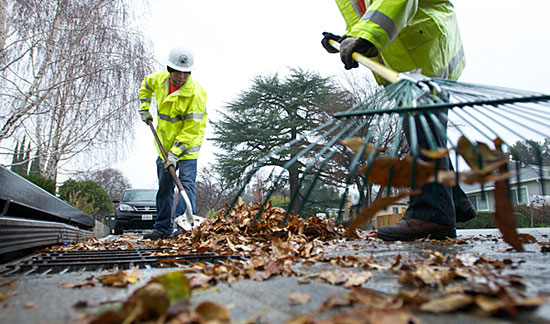



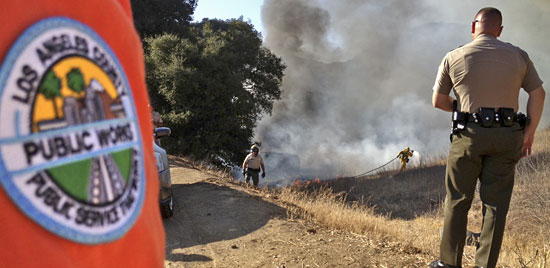
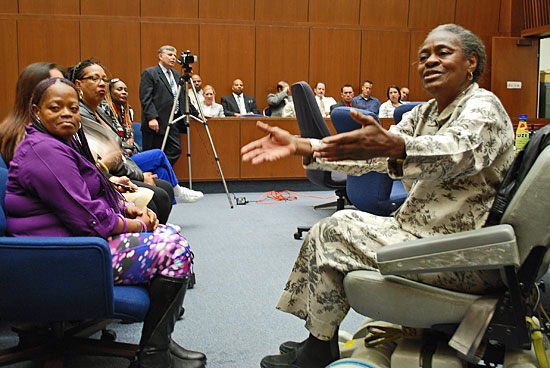

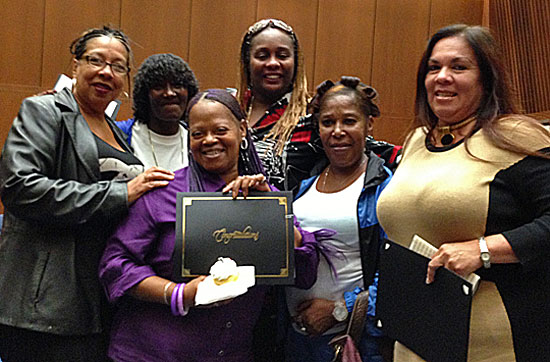
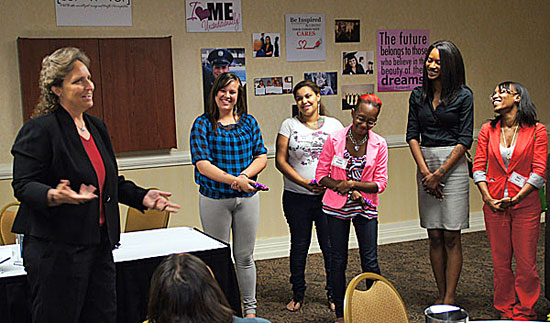
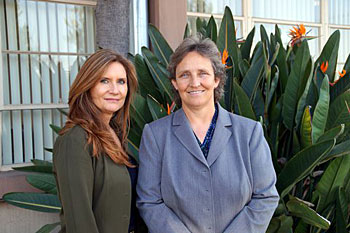
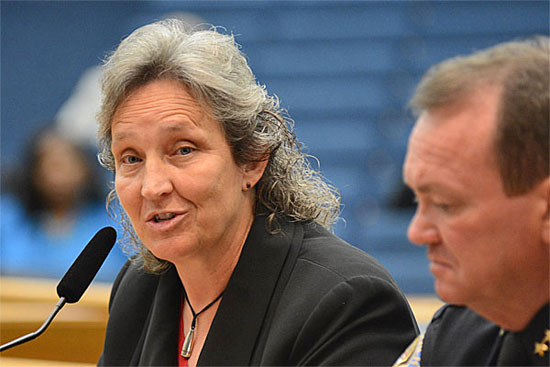

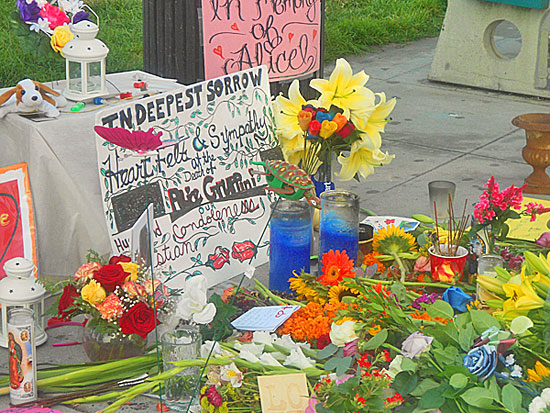

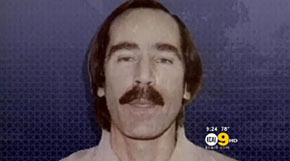







 405 bridge work causes a stink
405 bridge work causes a stink
